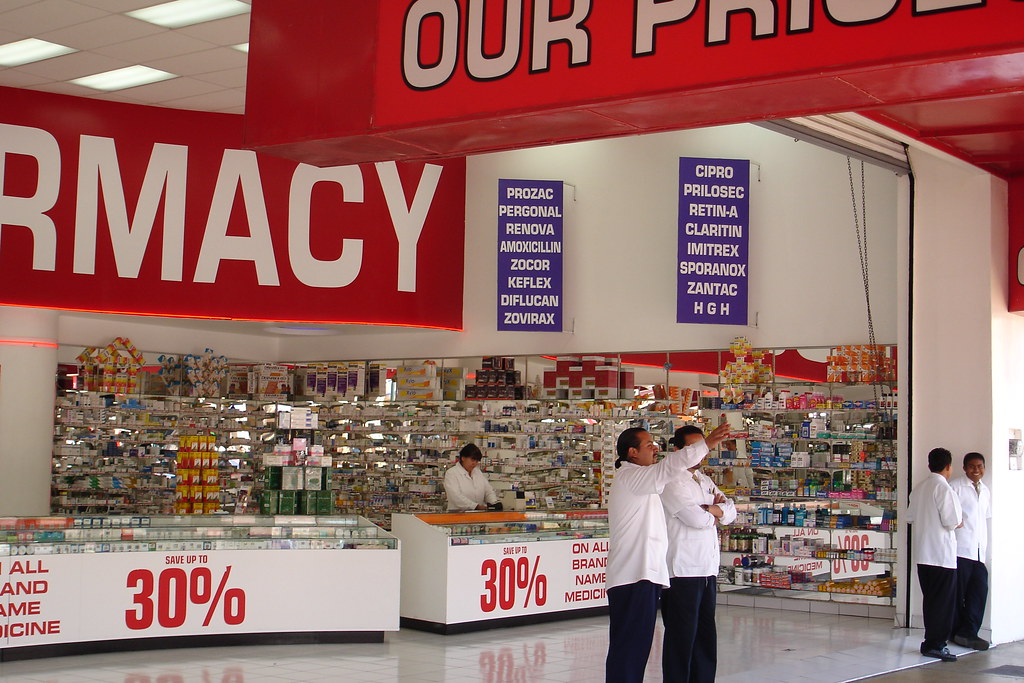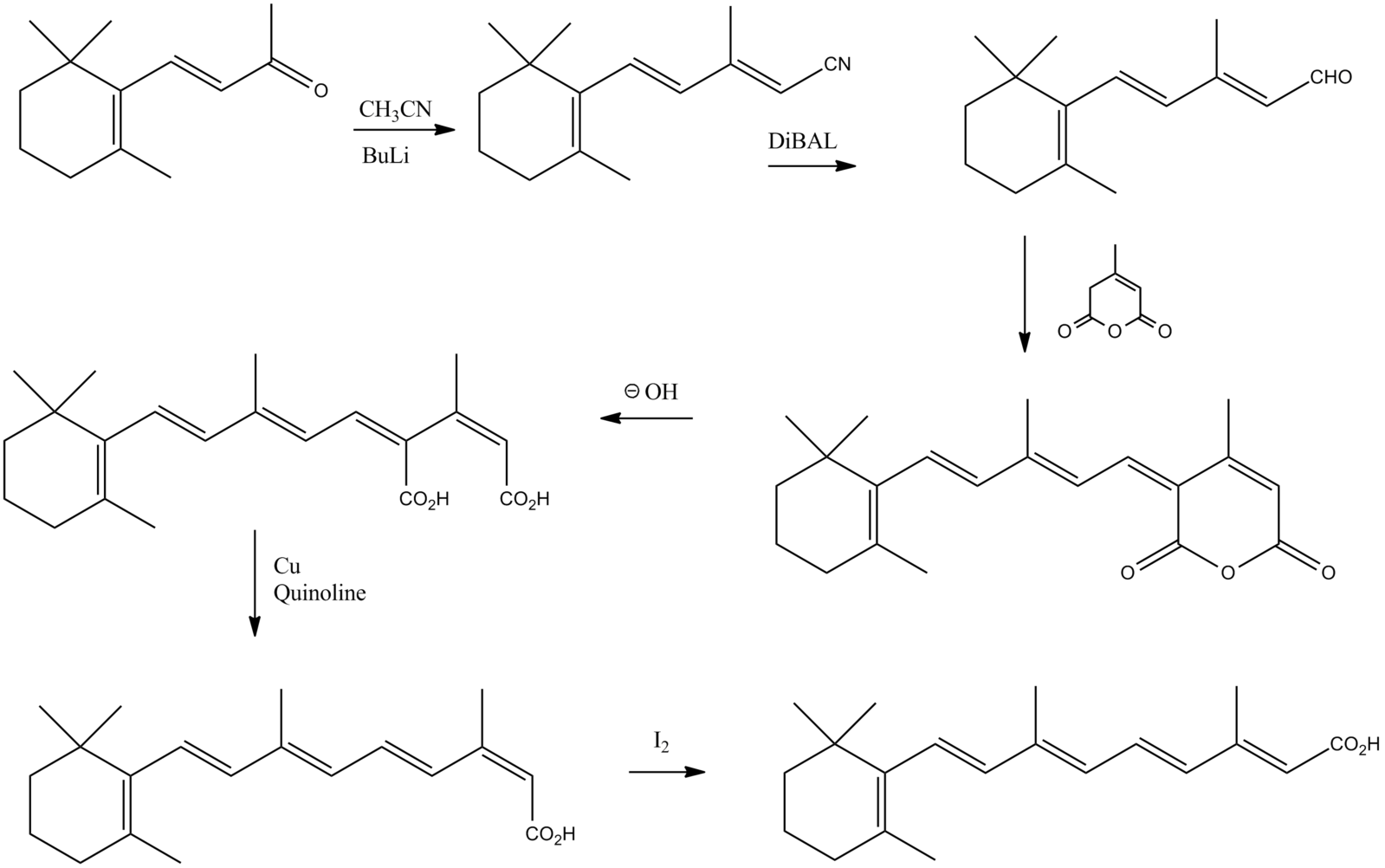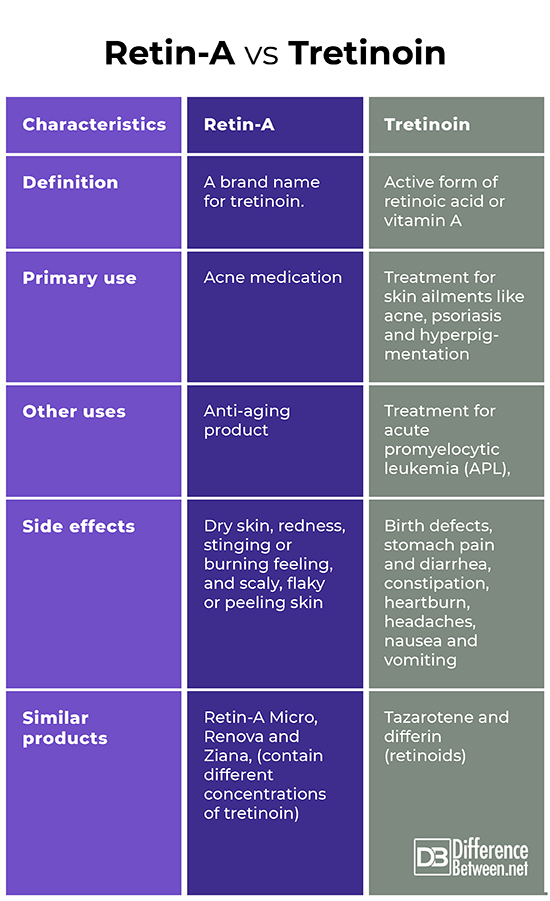Difference Between Retin-A and Tretinoin
Among dermatologists, skin care experts, and its users, there is no difference between Retin-A and tretinoin. However, calling all tretinoin or all acne treatment Retin-A is like calling all tissue paper Kleenex, or all chlorine and bleach products Clorox, or all photocopying machines Xerox. Retin-A is a brand name for a specific formulation of tretinoin, prescribed primarily for acne treatment. Tretinoin itself is a pharmacologically active form of retinoic acid, commonly known as vitamin A. Whether as Retin-A or in any other formulation, tretinoin is available by prescription only because of its powerful effects.
For lay people, differentiating Retin-A from tretinoin is splitting hairs, but it needs to be done. For one, Retin-A, although advertised as tretinoin, is not pure tretinoin. For another, tretinoin is also used as treatment for a specific kind of cancer. Retin-A and tretinoin are discussed and differentiated further in the following sections.
What is Retin-A?
Retin-A is a brand name for a special formulation and specific concentration of tretinoin, prescribed by doctors as a treatment for acne. This specific concentration that was effective as acne treatment was discovered by Dr. Albert Kligman and his colleagues during their experiments. The discovery was subsequently licensed to the company Johnson & Johnson which marketed Retin-A in 1971. Dr. Kligman also discovered that this same concentration made the skin of his patients smoother and wrinkles disappeared. Since then, Retin-A has been used as an anti-aging product even though it is still primarily prescribed and advertised today as acne treatment. Retin-A now also comes in many concentrations to suit various types of sensitive skin. Aside from acne, Retin-A is also prescribed by doctors to treat hyperpigmentation, or darkening of the skin, keratosis pilaris, psoriasis and wrinkles.
Tretinoin, the active ingredient in Retin-A is proven to be very effective in its action, which is to promote turnover of skin cells. Other skincare brand names that contain tretinoin as its active ingredient are Retin-A Micro, which is a milder and slower acting formulation, and Renova, which is marketed specifically as an anti-aging product for wrinkles. Another brand, Ziana, is a combination of tretinoin and clindamycin, an antibiotic also sometimes prescribed for acne. All of these topical medications have similar side effects because of tretinoin. Users typically experience dry skin, stinging or burning feeling plus redness, scaly, flaky or peeling skin and other conditions that are consistent with skin irritation.
What is Tretinoin?
Tretinoin is a pharmacologically active derivative of retinoic acid, more commonly known as vitamin A. It is the active ingredient in many prescription medications for acne and other skin problems, such as Retin-A discussed above. Although it is more famous as a skincare and beauty product ingredient, tretinoin is also used to treat a specific type of cancer called acute promyelocytic leukemia (APL), a type of cancer in which there are too many underdeveloped blood cells in the blood and bone marrow. Whereas tretinoin accelerates skin cell turnover in topical treatments, in the case of APL, tretinoin promotes the normal growth of the immature blood cells, causing a decrease in the signs and symptoms of the cancer.
Tretinoin is widely considered as the most common and most effective type of retinoid, chemicals which are derivatives of vitamin A – or are chemically similar, like retinols. Retinoids are chemical molecules that regulate the growth of a specific type of cells called epithelial cells, cells that line the surface of many body organs such as the skin, blood vessels and internal organs. These chemicals have been used to treat mostly topical ailments such as acne, or as skincare products, but have also been used to treat certain types of cancer, as in the case of APL. Aside from tretinoin, similar retinoids are tazarotene which works in the same way and also prescribed for similar skin conditions, and differin, which is a newer, over-the-counter alternative. Aside from the side effects of its topical formulations, tretinoin can cause birth defects so it is not to be used by those pregnant, planning to, or can get pregnant. Oral tretinoin can also cause stomach pain and diarrhea, constipation, heartburn, headaches, nausea, and vomiting.
Difference between Retin-A and Tretinoin
Definition
Retin-A is a brand name for a special formulation and specific concentration of tretinoin. Tretinoin is an active form of retinoic acid, commonly known as vitamin A.
Primary use
Retin-A is a medication primarily prescribed for acne. Tretinoin is also prescribed not only for acne but other skin ailments.
Other uses
Retin-A is used as an anti-aging product to reduce wrinkles and smoother skin. Tretinoin is also used to a specific type of cancer.
Side effects
Retin-A can irritates the skin and can cause dry skin, redness, stinging or burning feeling, and scaly, flaky, or peeling skin. Tretinoin can cause birth defects, stomach pain and diarrhea, constipation, heartburn, headaches, nausea, and vomiting
Similar products
Products similar to Retin-A are Retin-A Micro, Renova and Ziana, all of which contain different concentrations of tretinoin. Other retinoids similar to tretinoin are tazarotene and differin.
Retin-A Vs. Tretinoin
Summary
- Retin-A and tretinoin are two terms used interchangeably by doctors, skincare experts and users to refer to the prescription medication for acne but also commonly used as an anti-aging product.
- Retin-A is a brand name for a formulation for tretinoin effective for acne treatment, discovered by Dr. Albert Kligman and licensed and marketed by the company Johnson and Johnson in 1971.
- Tretinoin is a type of retinoid, specifically, the active derivative of retinoic acid, more commonly known as vitamin A. Tretinoin works by promoting the growth of epithelial cells, cells that line the surface of many body organs such as the skin, lungs, heart and blood vessels.
- Difference Between Hematoma and Melanoma - February 9, 2023
- Difference Between Bruising and Necrosis - February 8, 2023
- Difference Between Brain Hematoma and Brain Hemorrhage - February 8, 2023
Search DifferenceBetween.net :
Leave a Response
References :
[0]Image credit: https://commons.wikimedia.org/wiki/File:Tretinoin.png
[1]Image credit: https://live.staticflickr.com/22/28338669_6c0cae7caa_b.jpg
[2]Brannon, Heather L. "What to Know About Topical Retinoids for Acne." verywellhealth. December 11, 2019. https://www.verywellhealth.com/acne-treatment-with-topical-retinoids-1069599 (accessed January 21, 2020).
[3]Cirino, Erica. "Retin-A for Acne: What to Expect." healthline. January 25, 2019. https://www.healthline.com/health/skin/retin-a-for-acne (accessed January 21, 2020).
[4]Gellene, Denise. "Dr. Albert M. Kligman, Dermatologist, Dies at 93." The New York Times. February 22, 2010. https://www.nytimes.com/2010/02/23/us/23kligman.html?_r=0 (accessed January 21, 2020).
[5]The American Society of Health-System Pharmacists. "Tretinoin." MedlinePlus. September 15, 2016. https://medlineplus.gov/druginfo/meds/a608032.html (accessed January 13, 2020).



